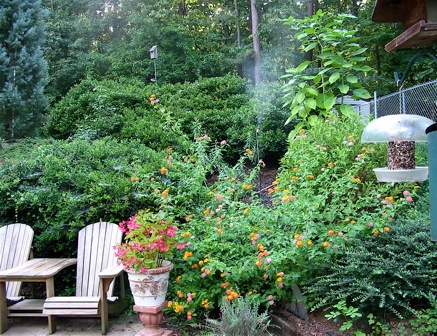-
fun birdhouse kits make great projects
A great project for any boys’ or girls’ youth group, or for something fun to do at home on a rainy day, bird feeder and birdhouse kits are the perfect choice!
Teaching children the importance of conservation, and learning about their immediate environment, birdhouse kit projects help to instill a valuable sense of stewardship with a fun, hands-on approach.
From Edible Feeder Kits, to “You Paint It” Wren House Kits, a large selection of reasonably priced birdhouse kits awaits assembly. Many require no tools at all, and some are more like puzzles with unique folding assemblies….meant for kids from age 4 to 104!
Recycled plastics have made their way to the birdhouse kit scene, with some vibrant colors and way cool designs.
They’re guaranteed to grab a child’s attention, while creating a useful roosting spot and nesting site for feathered friends.
- Bird Accessories, Bird Feeders, Bluebird Feeders, Fruit, Jelly & Mealworm Feeders, Mealworm Feeder, Recycled Bird Feeders, Uncategorized, Window Bird Feeder
Add a Mealworm Feeder to Entice Bluebirds
Bluebi
rds covet mealworms, in fact, I’ve discovered that lots of birds love these tasty morsels. In trying to attract bluebirds to this North Georgia yard, first came the bluebird house…but no luck. Then came a bluebird feeder, you know, the kind with the entrance holes that supposedly only bluebirds will fly into for food. Unfortunately that didn’t seem to work either, every different “bluebird delight” on the market was used.
After some quick research, it seemed live mealworms would do the trick, so I squeamishly ordered the first batch. They weren’t too bad, as long as I didn’t have to touch them! Unpacking and storing that first batch was pretty funny looking back at it now. Newspaper spread on the counter, latex gloves, and a semi-faint heart about the whole thing. Then just knowing I had a container of live worms in the fridge…omg! But I wanted to see bluebirds – so I persevered.
Not only did it work, it worked great…Eastern Bluebirds in my yard finally. Two or three showed up at first, and then they began to build a nest in the house. Watching the daily activity was fantastic. A few weeks later the babies started to fledge, one, two, three, four of th
em, all following mom and dad. Truly a great season! It didn’t take long for them to figure out how to enter the mealworm feeder and retrieve their own worms at will. The coolest thing is there was a second successful brood that season too. Watching the juveniles with the new fledgelings was absolutely awesome. Now I’m addicted to meal worms just as much as my bluebirds are. Making sure to feed them twice every day, close to the same time. My new friends stuck around all winter, likely due to the three heated birdbaths, and the regular feeding schedule.
Traditional bluebird feeders aren’t the only way to offer mealworms to feathered friends. Many dish-type styles have attachments for poles, making it simple to add a mealworm feeder to any existing feeding station. Tray type or platform feeders also have the capacity for worms, but there’s no guarantee the bluebirds will get them first. Maybe that’s where the saying “early bird catches the worm” comes from?
This recycled plastic mealworm feeder easily mounts to any standard one-inch diameter pole. The wooden Siamese Cat has a metal screen tray that’s perfect for offering worms too. The best part about these types of feeders is versatility. Foods like suet, peanuts and fruit may also be offered, depending on the species you’d like to attract and season.
- Bats & Butterflies, Bird Accessories, Butterfly Feeder, Misters and Birdbath Drippers, Uncategorized
Glass Butterfly Feeders and More
Innovative by design, with beauty to compliment any environment, these glass butterfly feeders work perfectly in any garden setting. With their rich hues, the large hand-blown glass flowers make for a fun and interesting focal point. Add versatility to this…and they become more than just feeders.
In our yard a red one sits just below a leaf mister, and as the water collects in the flower, it creates the perfect bath – not only for butterflies, but birds too! The unique shape allows for feeding nectar or fruit to butterflies as well. Over-ripened fruit like bananas, melon, peaches, pears and more can easily be placed in the flower. Add nectar to this glass flower with or without the use of a sponge.
When attracting butterflies, several factors come into play. Landscape and the use of flowers is an important one. Nectar producing plants, and host plants will yield the best results when used in conjunction with one another.
A water source is very helpful too, but butterflies do not use birdbaths. Puddlers are more suited for attracting these “flying flow
ers”. Puddlers are just what the name implies, pools of water, or puddles. They can range from small to large, plastic or stoneware, raised or at ground level. This puddler is handcrafted of weatherproof stoneware, so it stays in the garden year-round. It gives butterflies a place to dry in the sun (after bathing) with its’ smooth rock-like surface. Some puddlers may even be used as butterfly feeders, with spaces for offering fruit or nectar.
Butterfly accessories that are versatile and interchangeable are always a sure bet as you can try different things to see what works best for attracting these little guys to your garden.
A leaf mister in our yard sits in front of a glass butterfly feeder. Unfortunately from this angle, the feeder is hidden by shrubs. But it’s the perfect example of using a butterfly feeder as a bath instead.








